Experimental Study on IRV Ramming Artificial Model Ice
Abstract
:1. Introduction
Speed-Dependent Ramming Performance
2. Test Methods
2.1. Experimental Model
2.2. Model Scaling
- (1)
- Froude Number ()
- (2)
- Reynolds Number ()
- (3)
- Cauchy Number ()
2.3. Model Ice
2.4. Experimental Setup
3. Test Results and Analysis
3.1. Model Ramming and Icebreaking Phenomenon
3.2. Ice Penetration Distance
3.3. Bow Loads
4. Discussion
4.1. Ice Strength Scaling Guidelines
4.2. Destruction Modes of Ice
5. Summary and Conclusions
- (1)
- Similarity criteria: By summarizing the commonly used similarity criteria and deriving scaling rules applicable to model tests under ramming conditions, the similarity criteria for ramming experiments on level ice were established.
- (2)
- Model ice damage: In the ramming experiments under level ice conditions, the damage pattern of the model ice for the IRV initially involved localized bending and squeezing damage caused by the bow, followed by extensive bending damage initiated at the shoulder as the model ship climbed onto the ice surface with inertia.
- (3)
- Ramming distance: Under level ice conditions, there is a good linear correlation between the icebreaking distance and the sailing speed.
- (4)
- Contact load of the icebreaking ship’s bow: Under level ice conditions, both the average and extreme values of the contact load on the bow of the icebreaking ship increase with the increase in sailing speed.
Author Contributions
Funding
Institutional Review Board Statement
Informed Consent Statement
Data Availability Statement
Acknowledgments
Conflicts of Interest
References
- IMO. Guidelines for Ships Operating in Arctic Ice-Covered Waters; IMO Report; IMO: London, UK, 2002. [Google Scholar]
- Transport Canada Ship Safety. Arctic Ship Pollution Prevention Regulations. TP 12260E. 1985. Available online: https://faolex.fao.org/docs/pdf/can023168.pdf (accessed on 6 October 2019).
- Ahn, S.; Kee, L.T. A Study of the Change of Ship Speed according to the Ice Load Signal during Slow Ramming. J. Ocean Eng. Technol. 2019, 33, 627–631. [Google Scholar] [CrossRef]
- Yamauchi, Y.; Mizuno, S. Study on improvement in ramming performance of Antarctic icebreaker. In Proceedings of the 19th International Offshore and Polar Engineering Conference, Osaka, Japan, 21–26 June 2009; pp. 629–635. [Google Scholar]
- Nyseth, H.; Robert, F.; Sand, B. Evaluation of global ice load impacts based on real-time monitoring of ship motions. In Proceedings of the 22nd International Conference on Port and Ocean Engineering under Arctic Conditions, Espoo, Finland, 9–13 June 2013; Available online: http://www.poac.com/Papers/2013/pdf/POAC13_135.pdf (accessed on 1 October 2020).
- Lu, L.; Kujala, P.; Valdez Banda, O.A. Ramming induced ice loads between the ship bow and multiyear thick ice in Antarctic Weddell Sea. In Developments in the Collision and Grounding of Ships and Offshore Structures, Proceedings of the 8th International Conference on Collision and Grounding of Ships and Offshore Structures (ICCGS 2019), 21–23 October 2019, Lisbon, Portugal; CRC Press: Boca Raton, FL, USA, 2019; p. 204. Available online: https://acris.aalto.fi/ws/portalfiles/portal/38668124/ENG_Lu_et_al_Ramming_induced_ice_loads_Development_in_the_Collision_and_Grounding_of_Ships.pdf (accessed on 3 March 2021).
- Lee, J.M.; Lee, C.J.; Kim, Y.S.; Choi, G.G.; Lew, J.M. Determination of global ice loads on the ship using the measured full-scale motion data. Int. J. Nav. Archit. Ocean Eng. 2016, 8, 301–311. [Google Scholar] [CrossRef]
- Riska, K.; Bridges, R. Limit state design and methodologies in ice class rules for ships and standards for Arctic offshore structures. Mar. Struct. 2019, 63, 462–479. [Google Scholar] [CrossRef]
- Kotilainen, M.; Suominen, M.; Kujala, P. Rotating ice cusps on ship’s bow shoulder: Full-scale study on the cusp sizes and corresponding peak loads in different ice and operational conditions. Ocean Eng. 2019, 189, 106280. [Google Scholar] [CrossRef]
- Guo, C.; Zhang, C.; Feng, F.; Wang, C.; Wang, C. Predicting ship ramming performance in thick level ice via experiments. Ships Offshore Struct. 2022, 17, 2141–2149. [Google Scholar] [CrossRef]
- Luo, W.-Z.; Guo, C.-Y.; Wu, T.-C.; Su, Y.-M. Experimental research on resistance and motion attitude variation of ship–wave–ice interaction in marginal ice zones. Mar. Struct. 2018, 58, 399–415. [Google Scholar] [CrossRef]
- Myland, D.; Ehlers, S. Methodology to assess the floe size and distribution along a ship hull during model scale ice tests for self-propelled ships sailing ahead in level ice. Ships Offshore Struct. 2017, 12, S100–S108. [Google Scholar] [CrossRef]
- Zhang, Y.; Tao, L.; Wang, C.; Ye, L.; Guo, C. Numerical study on dynamic icebreaking process of an icebreaker by ordinary state-based peri dynamics and continuous contact detection algorithm. Ocean Eng. 2021, 233, 109148. [Google Scholar] [CrossRef]
- Zhang, Y.; Tao, L.; Wang, C.; Ye, L.; Sun, S. Numerical study of icebreaking process with two different bow shapes based on developed particle method in parallel scheme. Appl. Ocean Res. 2021, 114, 102777. [Google Scholar] [CrossRef]
- Junji, S. Numerical Simulation of Ship Ramming in Extremely Thick Ice. In Proceedings of the 26th International Conference on Port and Ocean Engineering under Arctic Conditions, Moscow, Russia, 14–18 June 2021; Available online: https://www.poac.com/Proceedings/2021/POAC21-068.pdf (accessed on 1 June 2022).
- Gao, Y.; Hu, Z.; Ringsberg, J.W.; Wang, J. An elastic–plastic ice material model for ship-iceberg collision simulations. Ocean Eng. 2015, 102, 27–39. [Google Scholar] [CrossRef]
- Xu, Y.; Hu, Z.; Ringsberg, J.W.; Chen, G. Nonlinear viscoelastic-plastic material modelling for the behavior of ice in ice-structure interactions. Ocean Eng. 2019, 173, 284–297. [Google Scholar] [CrossRef]
- Wang, C.; Hu, X.; Tian, T.; Guo, C.; Wang, C. Numerical simulation of ice loads on a ship in broken ice fields using an elastic ice model. Int. J. Nav. Archit. Ocean Eng. 2020, 12, 414–427. [Google Scholar] [CrossRef]
- Zhou, L.; Diao, F.; Song, M.; Han, Y.; Ding, S. Calculation Methods of Icebreaking Capability for a Double-Acting Polar Ship. J. Mar. Sci. Eng. 2020, 8, 179. [Google Scholar] [CrossRef]
- Zhao, W.; Johan Leira, B.; Vilhelm Høyland, K.; Kim, E.; Feng, G.; Chen, Z.; Gui, H. On the Structural Analysis of Icebreakers Due to Ramming of First-Year Ice Ridges. In Proceedings of the ASME 2022 41st International Conference on Ocean, Offshore and Arctic Engineering, Hamburg, Germany, 5–10 June 2022; Volume 6: Polar and Arctic Sciences and Technology, V006T07A029. ASME: New York, NY, USA, 2022. [Google Scholar] [CrossRef]
- Gong, H.; Polojärvi, A.; Tuhkuri, J. Discrete element simulation of the resistance of a ship in unconsolidated ridges. Cold Reg. Sci. Technol. 2019, 167, 102855. [Google Scholar] [CrossRef]
- Riska, K. On the Mechanics of the Ramming Interaction between a Ship and a Massive Ice Floe. Ph.D. Dissertation, Technical Research Centre of Finland, Espoo, Finland, 1987. [Google Scholar]
- ITTC. Test Methods for Model Ice Properties. ITTC Report. 2021. Available online: https://www.ittc.info/media/8061/75-02-04-02.pdf (accessed on 1 June 2022).
- ITTC. General Guidance and Introduction to Ice Model Testing. ITTC Report. 2021. Available online: https://www.ittc.info/media/9649/75-02-04-01.pdf (accessed on 1 June 2022).
- Chai, W.; Leira, B.J.; Hoyland, K.V.; Sinsabvarodom, C.; Yu, Z.L. Statistics of thickness and strength of first-year ice along the Northern Sea Route. J. Mar. Sci. Technol. 2021, 26, 331–343. [Google Scholar] [CrossRef]
- Myland, D.; Ehlers, S. Influence of bow design on ice breaking resistance. Ocean Eng. 2016, 119, 217–232. [Google Scholar] [CrossRef]
- Newman, J.C. NASA Technical Note, NASA TND 671; NASA: Washington, DC, USA, 1971. [Google Scholar]
- Timco, G.W.; Weeks, W.F. A review of the engineering properties of sea ice. Cold Reg. Sci. Technol. 2010, 60, 107–129. [Google Scholar] [CrossRef]
- Schwartz, J.; Frederking, R.; Gavrillo, V.; Petrov, I.G.; Hirayama, K.-I.; Mellor, M.; Tryde, P.; Vaudrey, K.D. Standardized Testing Methods for Measuring Mechanical Properties of Ice. Cold Reg. Sci. Technol. 1981, 4, 245–253. [Google Scholar] [CrossRef]
- Aly, M.; Taylor, R.; Bailey Dudley, E.; Turnbull, I. Scale effect in freshwater ice flexural strength. In Proceedings of the ASME 2018 37th OMAE Conference, Madrid, Spain, 17–22 June 2018. [Google Scholar]
- Ettema, R.; Gralher, S.; Kellner, L.; Stender, M. The non-linear behavior of aqueous model ice in downward flexure. Cold Reg. Sci. Technol. 2019, 165, 102775. [Google Scholar]
- Cole, D. The microstructure of ice and its influence on mechanical properties. Eng. Fract. Mech. 2001, 68, 1797–1822. [Google Scholar] [CrossRef]
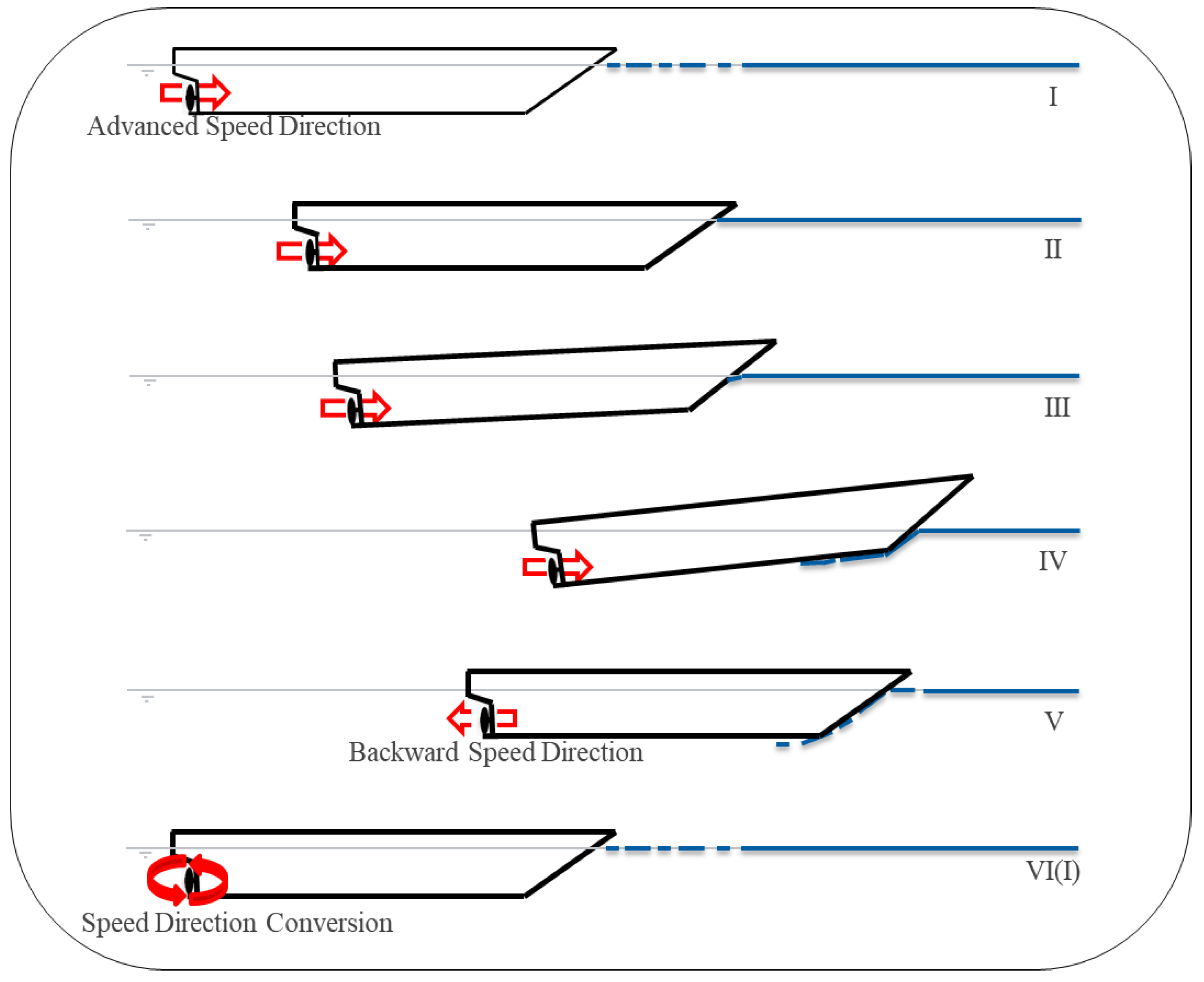
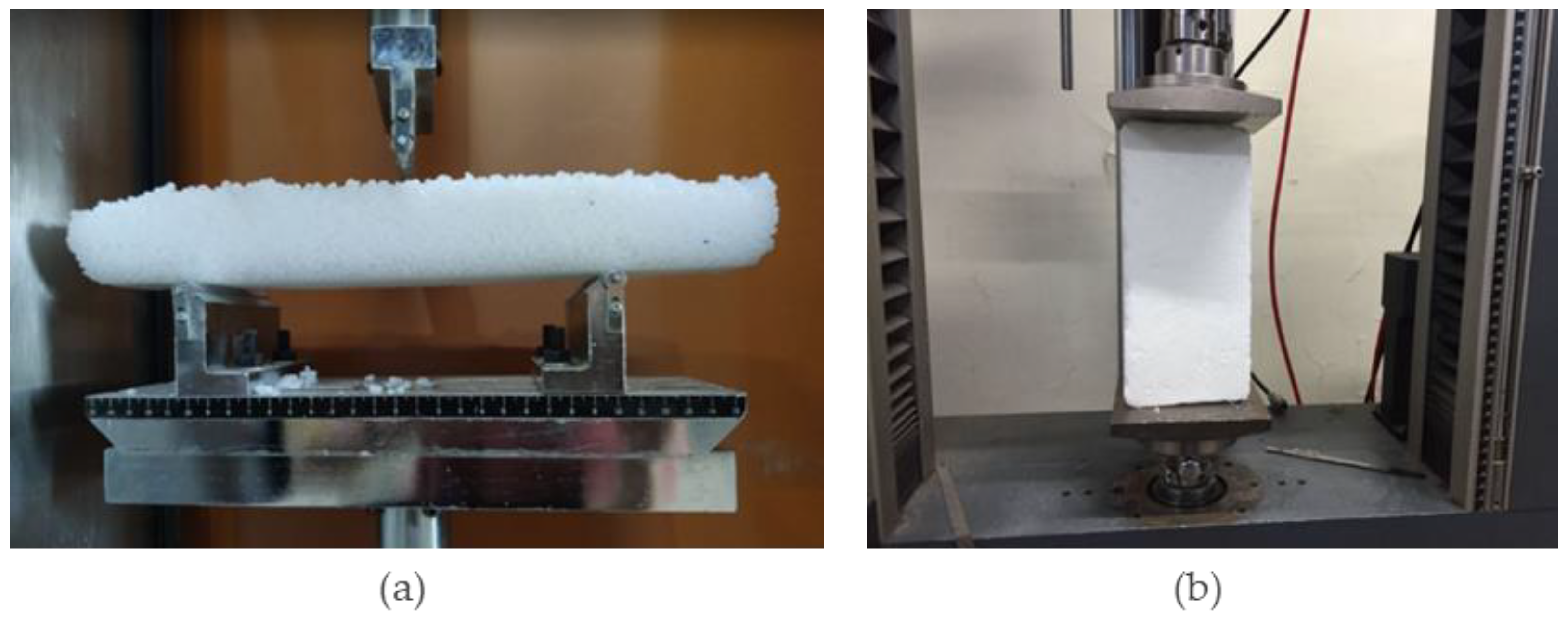
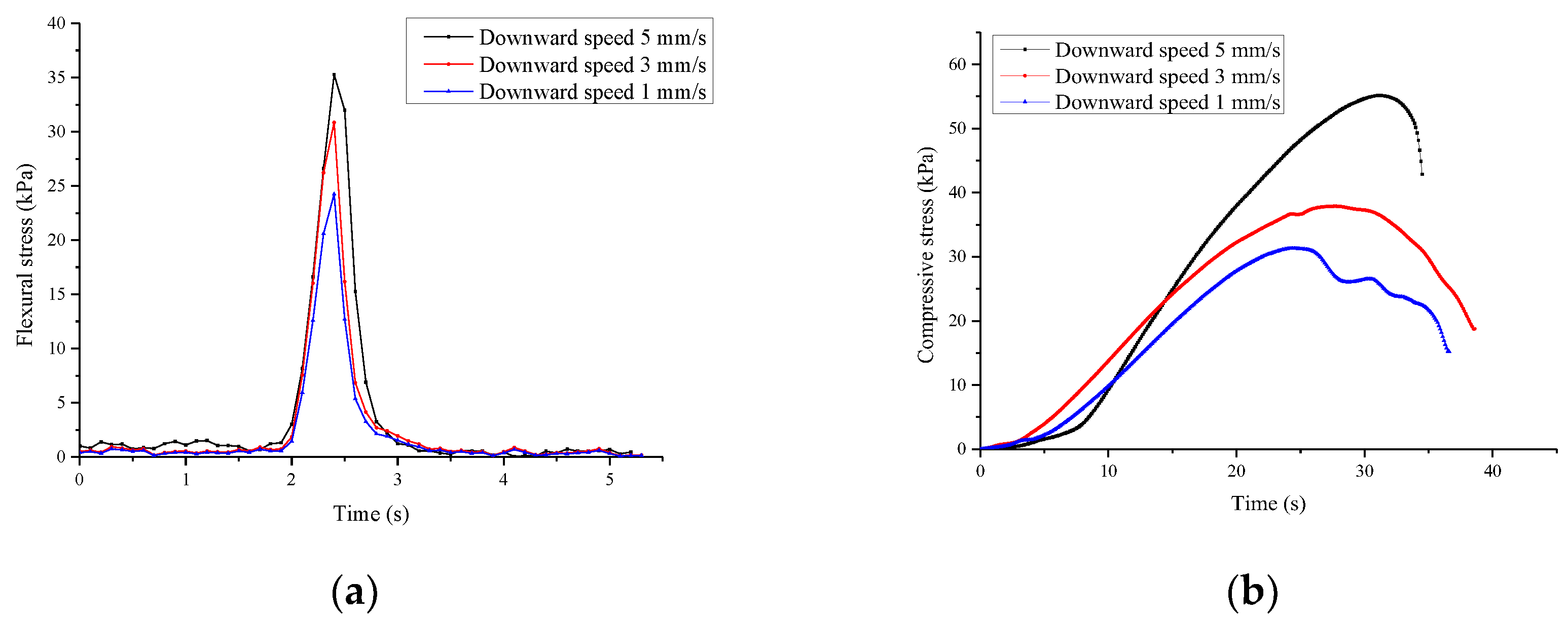
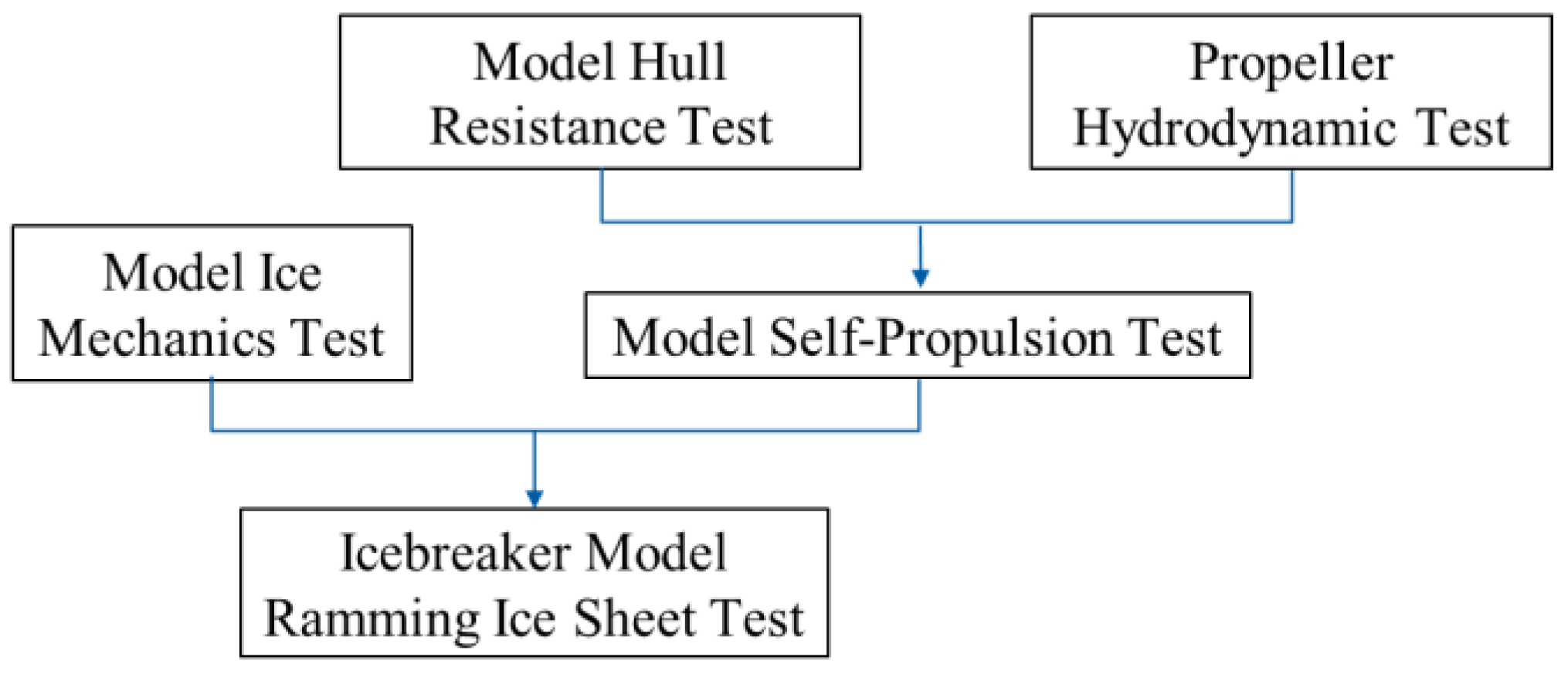
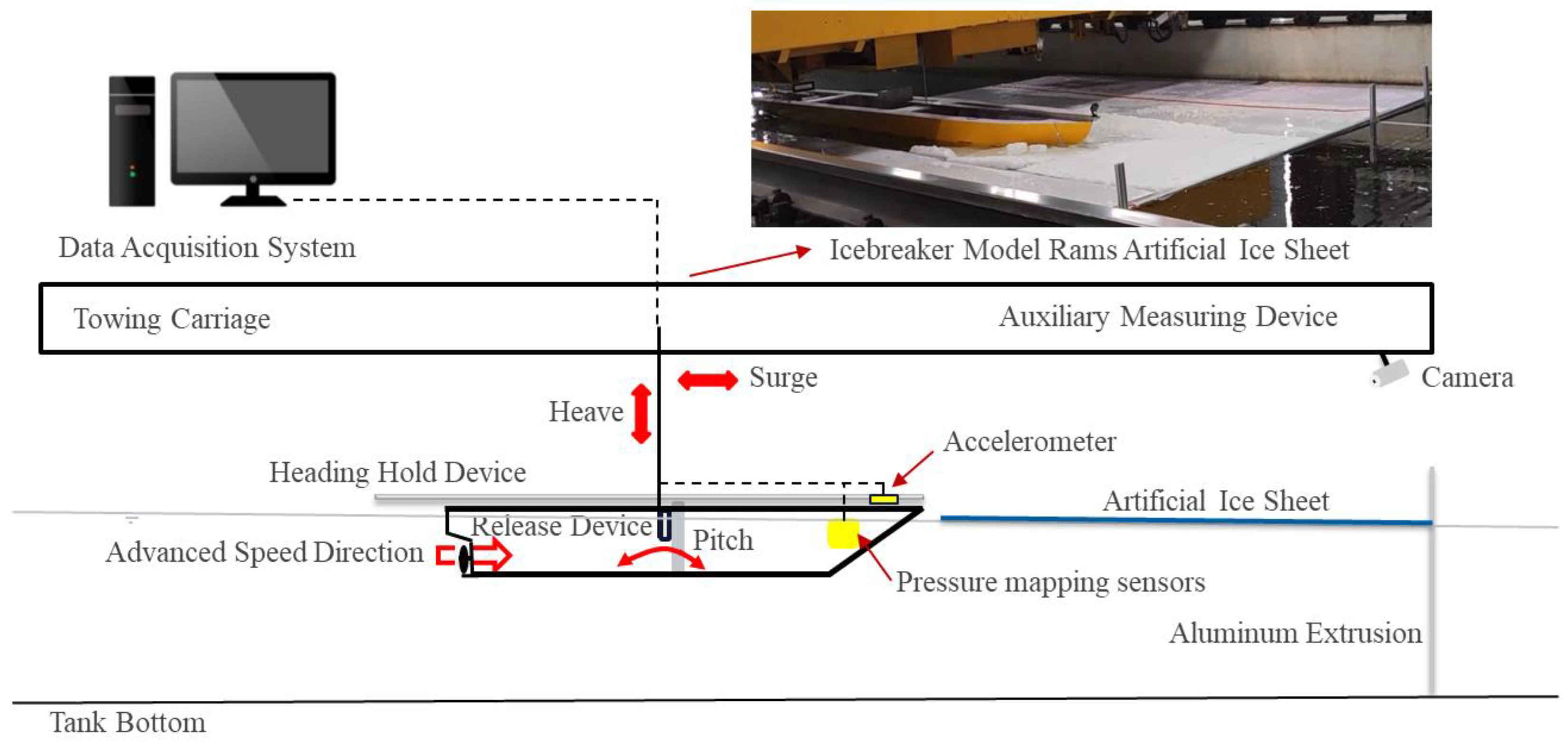

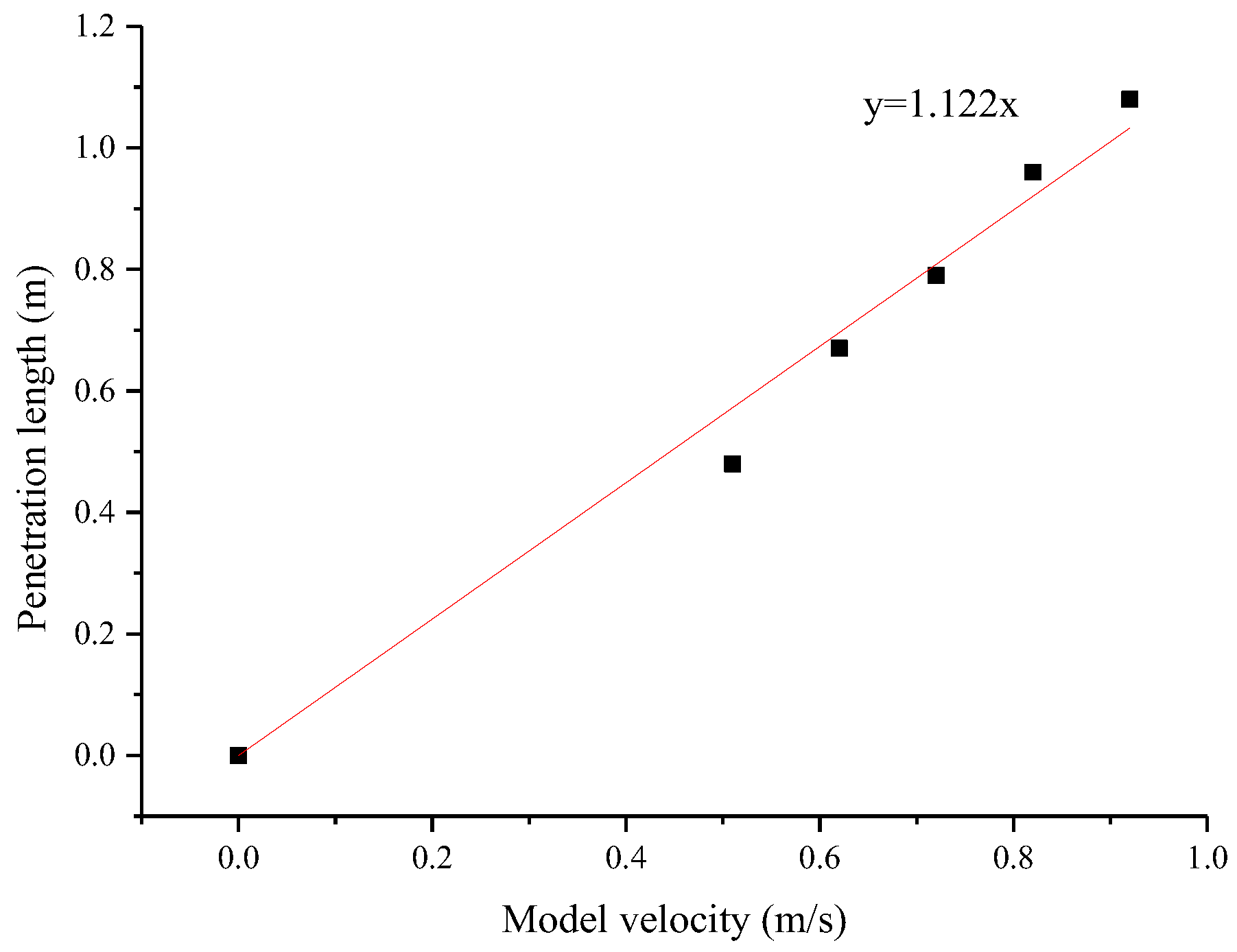
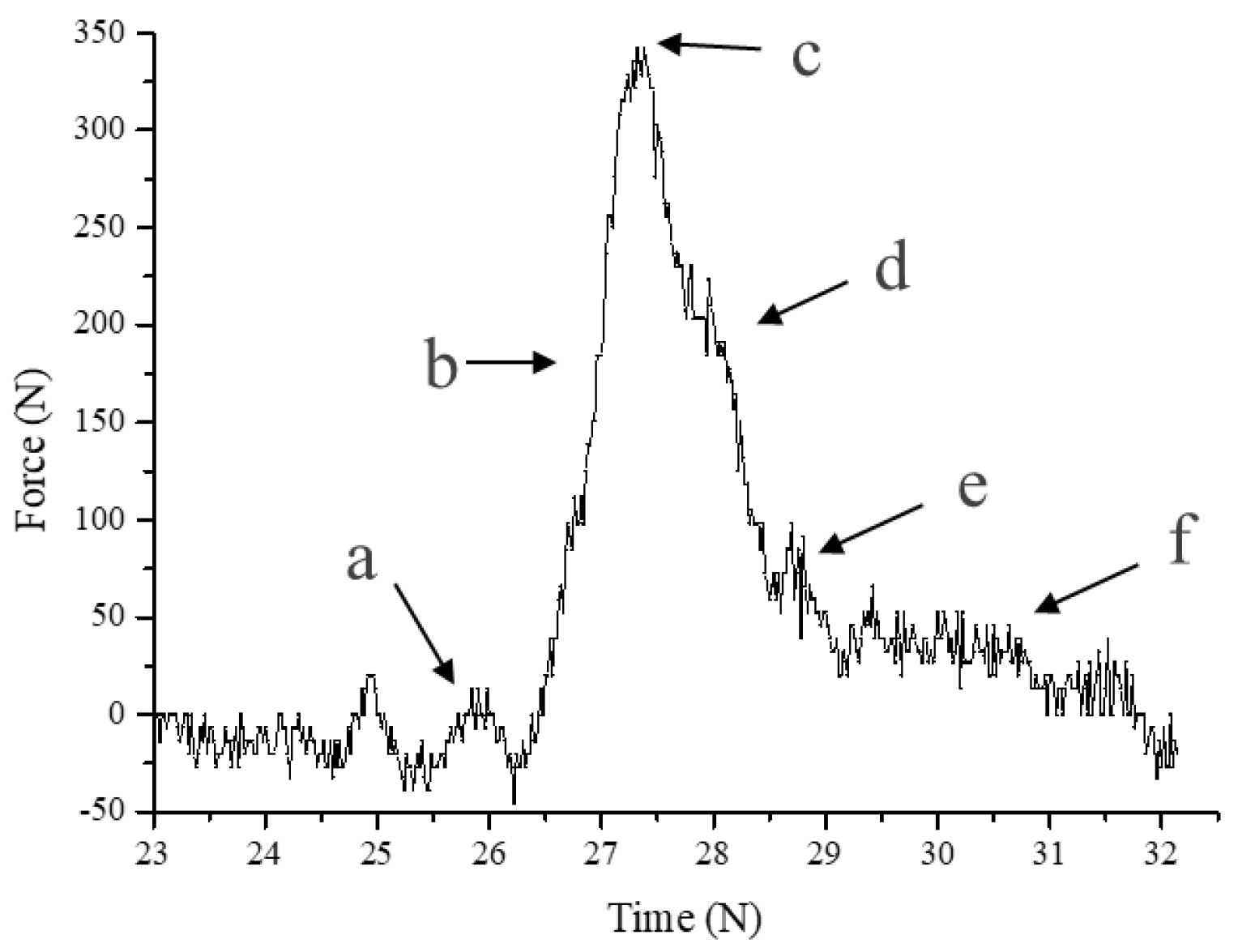
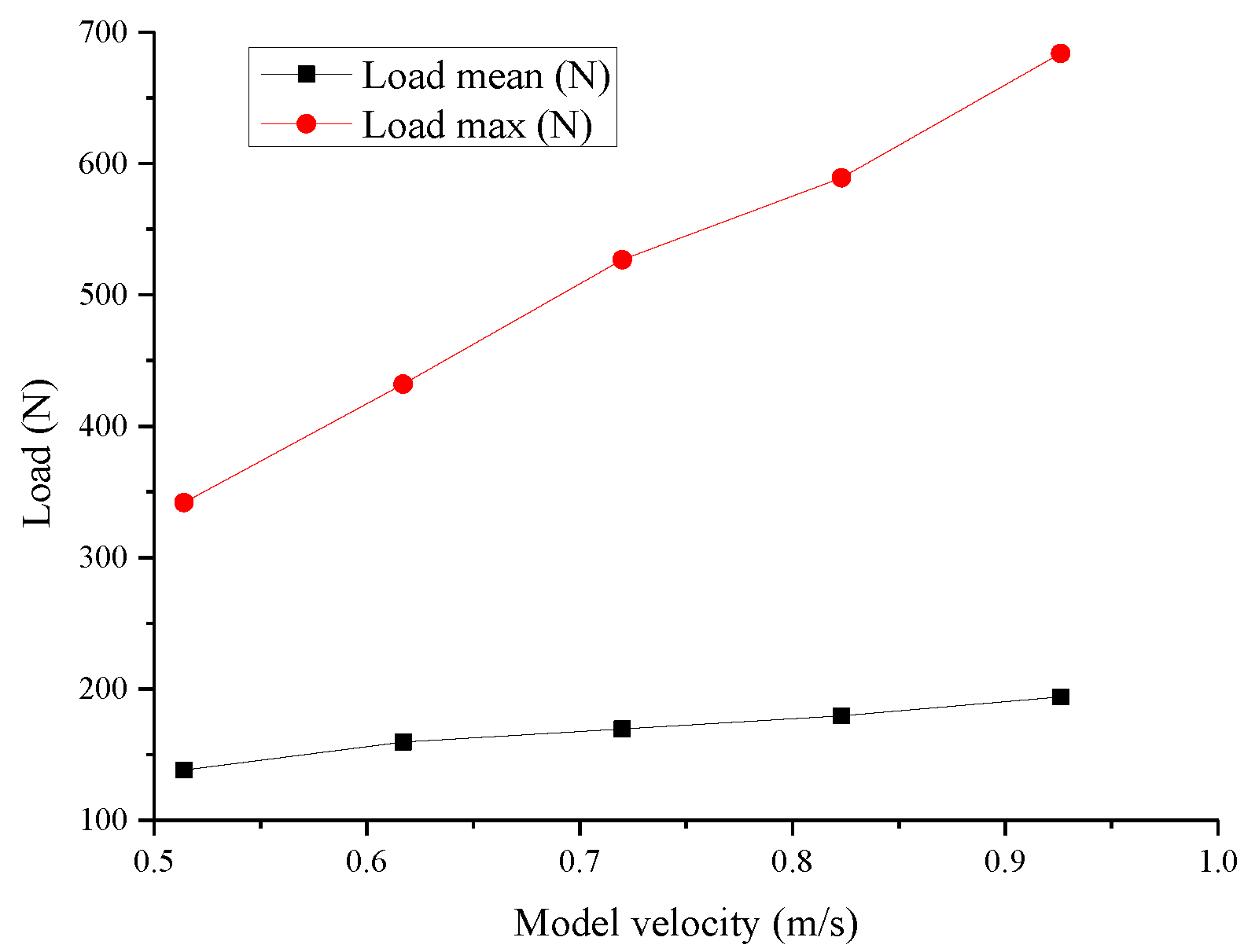
| Article | Research Methods | Ice Conditions | Model Ice Type | Ship Type | Results Evaluated |
|---|---|---|---|---|---|
| Ahn (2019) [3] | Full-scale test | Arctic ice | Sea ice | IRV | Ice load, Ship speed |
| Yamauchi (2009) [4] | Full-scale test | Thick ice | Sea ice | IRV | Ice load, Ship speed, Penetration |
| Nyseth (2013) [5] | Full-scale test | Sea ice edge | Sea ice | Icebreaker | Ice load, Ship speed, Ship Motions |
| Lu (2019) [6] | Full-scale test | Ice floes | Sea ice | PSRV | Ice load, Ship speed, Rudder angle, and power |
| Lee (2016) [7] | Full-scale test | Ice floes | Sea ice | IRV | Ice load, Ship motions |
| Kotilainen (2019) [9] | Full-scale test | Ice sheet | Sea ice | IRV | Ice load and ice conditions, Ship speed |
| Guo (2022) [10] | Model test | Level ice | Frozen ice | IRV | Ice load, Ship speed, Penetration |
| Luo (2018) [11] | Model test | Ice floes | Artificial ice | Bulker | Ice resistance, Ship speed, Ship motions |
| Myland (2017) [12] | Model test | Level ice | Frozen ice | IRV | Ice resistance, ice and ship parameters, ice floe size, and distribution |
| Zhang (2021) [13,14] | Model test & PD | Level ice | Frozen ice | IRV | Ice load, Ship speed |
| Sawamura (2021) [15] | Numerical Simulation | Thick plate ice | Sea ice | IRV | Penetration, Ship speed, Energy, Icebreaking force |
| Gao (2015) [16] | FEM | Iceberg | Sea ice | Tanker | Penetration, Ship speed, Stress |
| Main Dimension | Prototype | Model |
|---|---|---|
| LDWL | 149.3 m | 6.0 m |
| Lpp | 147.2 m | 5.9 m |
| B | 22.6 m | 0.9 m |
| D | 23 m | 0.6 m |
| T | 9.0 m | 0.4 m |
| Displacement | 17,543 t | 1.1 t |
| Parameters | Scale | Units | Parameters | Scale | Units |
|---|---|---|---|---|---|
| Length | m | Ice strength | kPa | ||
| Time | s | Ice thickness | m | ||
| Velocity | m/s | Elastic modulus | MPa | ||
| Force | N | Density | 1 | Kg/m3 | |
| Friction | 1 | - | Acceleration | 1 | m/s2 |
| Loading Speed | Uniaxial Compressive Strength | Three-Point Bending Strength |
|---|---|---|
| 1 mm/s | 31.29 kPa | 24.24 kPa |
| 3 mm/s | 37.89 kPa | 30.85 kPa |
| 5 mm/s | 55.14 kPa | 35.27 kPa |
| Ship Velocity | Model Velocity | Penetration Length | Load Mean | Load Max |
|---|---|---|---|---|
| 5 kts | 0.51 m/s | 0.48 m | 138.3 N | 341.9 N |
| 6 kts | 0.62 m/s | 0.67 m | 159.6 N | 432.1 N |
| 7 kts | 0.72 m/s | 0.79 m | 169.5 N | 526.8 N |
| 8 kts | 0.82 m/s | 0.96 m | 179.6 N | 589.1 N |
| 9 kts | 0.92 m/s | 1.08 m | 194.0 N | 683.8 N |
Disclaimer/Publisher’s Note: The statements, opinions and data contained in all publications are solely those of the individual author(s) and contributor(s) and not of MDPI and/or the editor(s). MDPI and/or the editor(s) disclaim responsibility for any injury to people or property resulting from any ideas, methods, instructions or products referred to in the content. |
© 2023 by the authors. Licensee MDPI, Basel, Switzerland. This article is an open access article distributed under the terms and conditions of the Creative Commons Attribution (CC BY) license (https://creativecommons.org/licenses/by/4.0/).
Share and Cite
Guo, C.; Zhang, C.; Wang, C.; Wang, C. Experimental Study on IRV Ramming Artificial Model Ice. J. Mar. Sci. Eng. 2023, 11, 2022. https://doi.org/10.3390/jmse11102022
Guo C, Zhang C, Wang C, Wang C. Experimental Study on IRV Ramming Artificial Model Ice. Journal of Marine Science and Engineering. 2023; 11(10):2022. https://doi.org/10.3390/jmse11102022
Chicago/Turabian StyleGuo, Chunyu, Chengsen Zhang, Chunhui Wang, and Chao Wang. 2023. "Experimental Study on IRV Ramming Artificial Model Ice" Journal of Marine Science and Engineering 11, no. 10: 2022. https://doi.org/10.3390/jmse11102022





